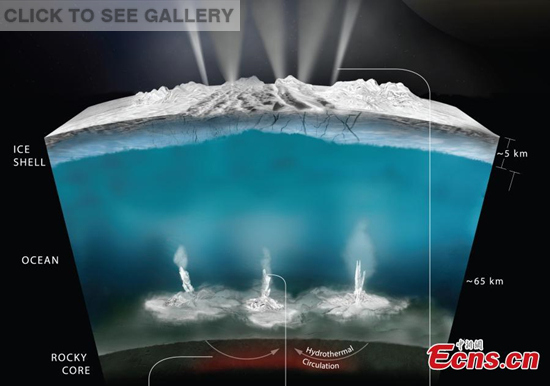NASA's Cassini spacecraft detected the presence of molecular hydrogen in water plumes erupting from Saturn's icy moon Enceladus, the U.S. space agency announced Thursday, suggesting that the distant world has almost all the conditions necessary for life.
"We detected hydrogen in the plume of Enceladus," Linda Spilker, Cassini project scientist at NASA's Jet Propulsion Laboratory said at a webcast news briefing. "This is a very significant finding because the hydrogen could be a potential source of chemical energy for any microbes that might be in the Enceladus ocean."
With this finding, "we now know Enceladus has almost all of the ingredients that you need to support life as we know it on Earth," Spilker said.
Life as we know it requires three primary ingredients: liquid water; a source of energy for metabolism; and the right chemical ingredients, primarily carbon, hydrogen, nitrogen, oxygen, phosphorus and sulfur.
Cassini has not yet shown phosphorus and sulfur are present in the ocean of Enceladus, but according to NASA, scientists suspect them to be, since its rocky core is thought to be chemically similar to meteorites that contain the two elements.
The Cassini spacecraft detected the hydrogen in the plume of gas and icy material spraying from Enceladus during its last, and deepest, dive through the plume on Oct. 28, 2015.
Cassini also sampled the plume's composition during flybys earlier in the mission.
From these observations scientists have determined that nearly 98 percent of the gas in the plume is water, about one percent is hydrogen and the rest is a mixture of other molecules including carbon dioxide, methane and ammonia.
The new findings, published in the U.S. journal Science, are an independent line of evidence that hydrothermal activity is taking place in the ocean of Enceladus, a small, icy moon a billion miles farther from the sun than Earth.
Previous results, published in March 2015, suggested hot water is interacting with rock beneath the sea, and the new findings support that conclusion and add that the rock appears to be reacting chemically to produce the hydrogen, NASA said.
In a related perspective, Jeffrey Seewald of the Woods Hole Oceanographic Institution, who was not involved in the study, described the findings as "an important advance in assessing the habitability of Enceladus."
"If correct, this observation has fundamental implications for the possibility of life on Enceladus," Seewald wrote. "Chemical disequilibrium that is known to support microbial life in Earth's deep oceans is also available to support life in the Enceladus ocean."
Also on Thursday, NASA researchers using the Hubble Space Telescope reported in The Astrophysical Journal Letters additional evidence of plumes erupting from Jupiter's moon Europa, indicating that the ocean-bearing world may be another ideal place to look for alien life.
"It's another great day of science," Thomas Zurbuchen, associate administrator for NASA's Science Mission Directorate, told reporters. "With this research, we're making a big step forward towards answering the question: is there life out there?"



















































